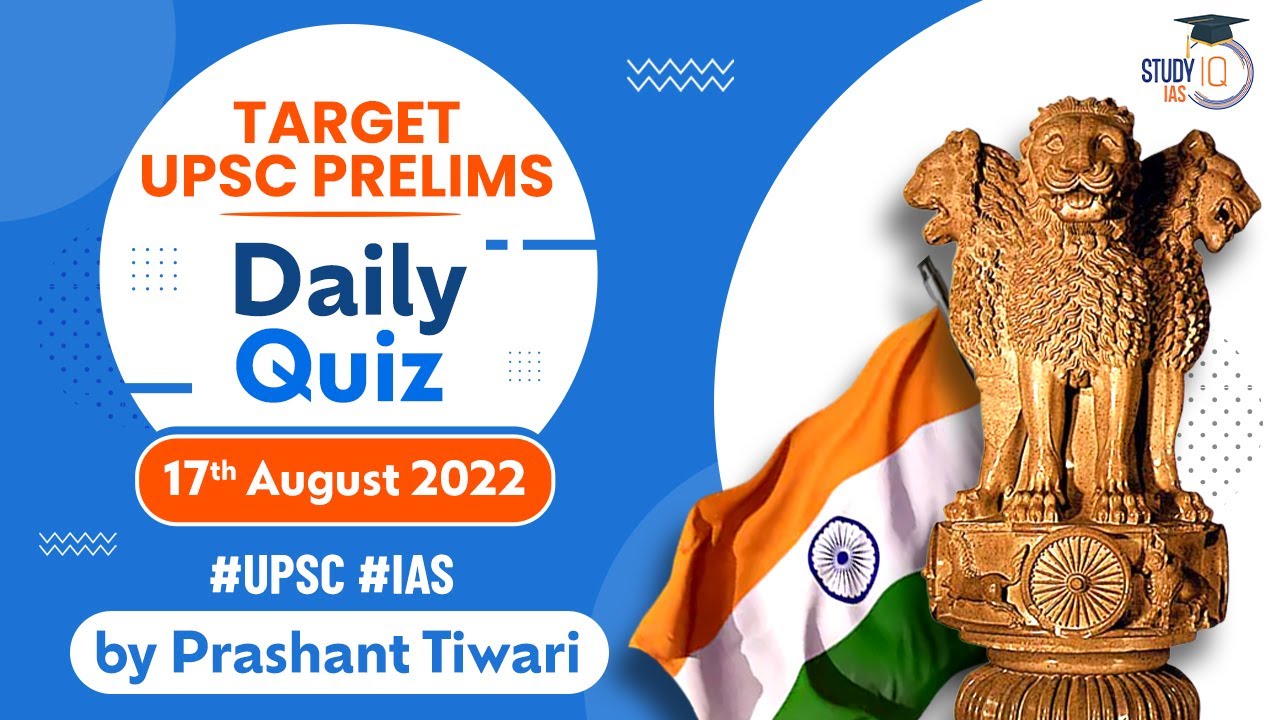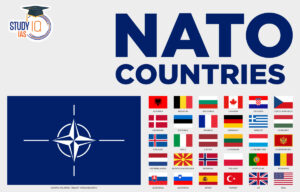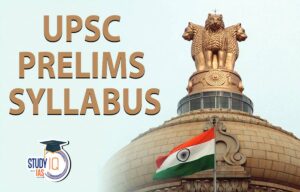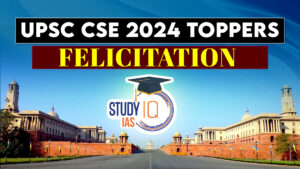Q) With reference to Fundamental duties, consider the following statements:
- The Fundamental Duties in the Indian Constitution are inspired by the Constitution of erstwhile USSR
- They refer that the State shall promote with special care the educational and economic interests of the weaker section.
- They refer that every citizen shall promote harmony and the spirit of common brotherhood amongst all the people of India.
Which of the statements given above is/are correct?
- Only 1
- Only 1 and 3
- Only 2 and 3
- All of the above
Q.) मौलिक कर्तव्यों के संदर्भ में, निम्नलिखित कथनों पर विचार करें:
- भारतीय संविधान में मौलिक कर्तव्य तत्कालीन सोवियत संघ के संविधान से प्रेरित हैं
- वे कहते हैं कि राज्य कमजोर वर्ग के शैक्षिक और आर्थिक हितों को विशेष सावधानी के साथ बढ़ावा देगा।
- वे कहते हैं कि प्रत्येक नागरिक भारत के सभी लोगों के बीच सद्भाव और समान भाईचारे की भावना को बढ़ावा देगा।
ऊपर दिए गए कथनों में से कौन–सा/से सही है/हैं?
- केवल 1
- केवल 1 और 3
- केवल 2 और 3
- उपरोक्त सभी
Answer :B
Explanation
Fundamental duties
-
- The Fundamental Duties in the Indian Constitution are inspired by the Constitution of erstwhile USSR.They refer that every citizen shall be abide by the Constitution and respect its ideals and institutions, the National Flag and the National Anthem
- They refer that every citizen shall promote harmony and the spirit of common brotherhood amongst all the people of India.
DPSP
-
- They refer that the State shall promote with special care the educational and economic interests of the weaker section.
Q) With reference to the DigiYatra, consider the following statements:
- It is a passenger processing system based on facial recognition technology.
- DigiYatra envisages that travellers pass through various checkpoints at the airport through paperless and contactless processing, using facial features to establish their identity, which would be linked to the boarding pass.
Which of the above statements is/are correct?
- 1 only
- 2 only
- Both 1 and 2
- Neither 1 nor 2
Q.) डिजीयात्रा के संदर्भ में निम्नलिखित कथनों पर विचार कीजिएः
- यह चेहरे की पहचान तकनीक पर आधारित एक यात्री प्रसंस्करण प्रणाली है।
- डिजीयात्रा में यात्रियों को अपनी पहचान स्थापित करने के लिए चेहरे की विशेषताओं का उपयोग करते हुए कागज रहित और संपर्क रहित प्रसंस्करण के माध्यम से हवाई अड्डे पर विभिन्न चौकियों से गुजरने की परिकल्पना की गई है, जिसे बोर्डिंग पास से जोड़ा जाएगा।
उपरोक्त में से कौन सा/से कथन सही है/हैं?
- केवल 1
- केवल 2
- दोनों 1 और 2
- न तो 1 और न ही 2
Answer – c
-
- The Delhi International Airport Ltd (DIAL), run by GMR, announced the soft launch of the Centre’s DigiYatra initiative, rolling out the beta version of its app for Android platforms.
- DigiYatra , the passenger processing system based on facial recognition technology, has been piloted at the Delhi airport and has had the required infrastructure set up at the airport’s Terminal 3.
- DigiYatra envisages that travellers pass through various checkpoints at the airport through paperless and contactless processing, using facial features to establish their identity, which would be linked to the boarding pass.
Q) With reference to the Council of Scientific & Industrial Research (CSIR), consider the following statements:
- It was set up in 1942as an autonomous body (under the Societies Registration Act, 1860).
- It comes under the administrative supervision of the Ministry of Education, Government of India.
Which of the above statements is/are correct?
- 1 only
- 2 only
- Both 1 and 2
- Neither 1 nor 2
Q.) वैज्ञानिक और औद्योगिक अनुसंधान परिषद (सीएसआईआर) के संदर्भ में, निम्नलिखित कथनों पर विचार करें:
- इसे 1942 में एक स्वायत्त निकाय के रूप में स्थापित किया गया था (सोसाइटी पंजीकरण अधिनियम, 1860 के तहत)।
- यह शिक्षा मंत्रालय, भारत सरकार के प्रशासनिक पर्यवेक्षण के अंतर्गत आता है।
उपरोक्त में से कौन सा/से कथन सही है/हैं?
- केवल 1
- केवल 2
- दोनों 1 और 2
- न तो 1 और न ही 2
Answer – A
Council of Scientific & Industrial Research (CSIR):
-
- It was set up in 1942as an autonomous body (under the Societies Registration Act, 1860).
- CSIR is now the largest government funded multi-disciplinary industrial research and development (R&D) organisation in India.
- It comes under the administrative supervision of the Ministry of Science and Technology, Government of India.
- The R&D activities of CSIR include aerospace engineering, structural engineering, ocean sciences, life sciences, metallurgy, chemicals, mining, food, petroleum, leather and environmental science.
- CSIR is headquartered in New Delhi.
Q) According to the Constitution, Territory of India includes which of the following categories:
- Territories of the states
- Union territories
- Territories that may be acquired by the Government of India at any time
Select the correct answer code:
- Only1
- Only1 and 2
- Only2 and 3
- All of the above
Q.) संविधान के अनुसार, भारत के क्षेत्र में निम्नलिखित में से कौन सा शामिल है
श्रेणियाँ:
- राज्यों के क्षेत्र
- केंद्र शासित प्रदेश
- वे क्षेत्र जो भारत सरकार द्वारा किसी भी समय अधिग्रहित किए जा सकते हैं
सही उत्तर कोड चुनें:
- केवल 1
- केवल 1 और 2
- केवल 2 और 3
- उपरोक्त सभी
Answer: D
Explanation:
According to Article 1, the territory of India can be classified into three categories:
-
- Territories of the states
- Union territories
- Territories that may be acquired by the Government of India at any time.
Q) Article 1 of our Constitution says – “India that is Bharat, shall be a Union of states”.
This declaration signifies:
- That the Union of India has resulted out of an agreement between the states.
- The component units/states have no right to secede from the Union.
Which of the above statements is/are correct?
- 1 only
- 2 only
- Both 1 and 2
- Neither 1 nor 2
Q.) हमारे संविधान का अनुच्छेद 1 कहता है – “भारत जो भारत है, राज्यों का एक संघ होगा“।
यह घोषणा दर्शाती है:
- कि भारत संघ राज्यों के बीच एक समझौते के परिणामस्वरूप हुआ है।
- संघटक इकाइयों/राज्यों को संघ से अलग होने का कोई अधिकार नहीं है।
उपरोक्त में से कौन सा/से कथन सही है/हैं?
- केवल 1
- केवल 2
- दोनों 1 और 2
- न तो 1 और न ही 2
Answer – B
Explanation:
-
- Article 1 describes India, that is, Bharat as a ‘Union of States’ rather than a ‘Federation of States’.
- According to Dr B R Ambedkar, the phrase ‘Union of States’ has been preferred to ‘Federation of States’ for two reasons: one, the Indian Federation is not the result of an agreement among the states like the American Federation; and two, the states have no right to secede from the federation.
Q) Consider the following statements about the Government of India Act 1858.
- It abolished the East India Company Rule in India.
- It changed the entire structure of government in India prevailing earlier.
- As per the Act, Indian Government was to be supervised and controlled in England.
Which of the above statements is/are correct?
- Only 1 and 2
- Only 2 and 3
- Only 1 and 3
- All of the above
Q.) भारत सरकार अधिनियम 1858 के बारे में निम्नलिखित कथनों पर विचार करें।
- इसने भारत में ईस्ट इंडिया कंपनी के शासन को समाप्त कर दिया।
- इसने भारत में पहले से प्रचलित सरकार के पूरे ढांचे को बदल दिया।
- अधिनियम के अनुसार, इंग्लैंड में भारत सरकार की देखरेख और नियंत्रण किया जाना था।
उपरोक्त में से कौन सा/से कथन सही है/हैं?
- केवल 1 और 2
- केवल 2 और 3
- केवल 1 और 3
- उपरोक्त सभी
Solution: C
-
- Explanation: Government of India Act 1858 :is also known as Act for the Good Government of India. Enacted in the wake of the Revolt of 1857. Abolished East India Company rule, and transferred powers of government, territories and revenues to the British Crown.
Features of the Act:
-
- It provided that India henceforth was to be governed by, and in the name of, Her Majesty. It changed the designation of the Governor-General of India to that of Viceroy of India. He (viceroy) was the direct representative of the British Crown in India. Lord Canning thus became the first Viceroy of India.
- It ended the system of double government by abolishing the Board of Control and Court of Directors.
Q) Which of the following is/are included in the Directive Principles of State Policy?
- Prohibition of traffic in human beings and forced labour
- Prohibition of consumption of intoxicating drinks and of other drugs which are injurious to health, except for medicinal purposes.
Which of the above statements is/are correct?
- 1 only
- 2 only
- Both 1 and 2
- Neither 1 nor 2
Q.) निम्नलिखित में से कौन राज्य के नीति निदेशक तत्वों में शामिल है/हैं?
- मानव के यातायात एवं बलात् श्रम का प्रतिषेध
- नशीले पेय और अन्य नशीले पदार्थों के सेवन का प्रतिषेध जो स्वास्थ्य के लिए हानिकारक, औषधीय प्रयोजनों को छोड़कर।
उपरोक्त में से कौन सा/से कथन सही है/हैं?
- केवल 1
- केवल 2
- दोनों 1 और 2
- न तो 1 और न ही 2
Answer – B
Explanation
-
- Prohibition of traffic in human beings and forced labour are Fundamental rights under article 23 and 24.
- Prohibition of consumption of intoxicating drinks and of other drugs which are injurious to health, except for medicinal purposes comes under article 47 of the DPSPs
Q) Which of the following countries is/are the members of BIMSTEC (Bay of Bengal Initiative for Multi-Sectoral Technical and Economic Cooperation)?
- Sri Lanka
- Myanmar
- Thailand
Select the correct answer using the code given below:
- 1 only
- 1 and 2 only
- 2 and 3 only
- 1, 2, and 3
Q.) निम्नलिखित में से कौन सा देश बिम्सटेक (बहु–क्षेत्रीय तकनीकी और आर्थिक सहयोग के लिए बंगाल की खाड़ी पहल) का सदस्य है/हैं?
- श्रीलंका
- म्यांमार
- थाईलैंड
नीचे दिए गए कूट का प्रयोग कर सही उत्तर चुनिए:
- केवल 1
- केवल 1 और 2
- केवल 2 और 3
- 1, 2, और 3
- It currently has 7 Member States, with:
- 5 Members from South Asia that is Bangladesh, India, Sri Lanka, Nepal & Bhutan.
- 2 from South-East Asia that is Myanmar and Thailand.
Q) Rajya Sabha has equal powers with Lok Sabha in
- the matter of creating new All India Services
- amending the Constitution
- the removal of the government
- making cut motions
Q.) राज्यसभा के पास लोकसभा के समान अधिकार हैं
- नई अखिल भारतीय सेवाएं बनाने का मामला
- संविधान में संशोधन
- सरकार को हटाने
- कटौती गति बनाना
Answer: (b)
Explanation:
-
- Rajya Sabha has equal powers with Lok Sabha in the amendment of the constitutional bill. Unlike money bill, the constitutional amendment bill has to be approved by both the houses of Parliament with special majority. There is no provision of Joint Session in case of disagreement, so, Lok Sabha cannot override the decision of Rajya Sabha. However, in the matters of formation and removal of government, the Rajya Sabha has unequal status with respect to Lok Sabha. Similarly, Rajya Sabha has less powers in the matters of finance like making cut motions, passing money bill, etc. vis-a-vis Lok Sabha. The Rajya Sabha has been given some special powers which it enjoys exclusively. This includes power to authorise the Parliament to create new All-India Services common to both the Centre and states (Article 312) by passing a resolution.
Q) Consider the following statements:
- The President of India can summon a session of the Parliament at such place as he/she thinks fit.
- The Constitution of India provides for three sessions of the Parliament in a year, but it is not mandatory to conduct all three sessions.
- There is no minimum number of days of that the Parliament is required to meet in a year.
Which of the statements given above is/are correct?
- 1 only
- 2 only
- 1 and 3 only
- 2 and 3 only
Q.) निम्नलिखित कथनों पर विचार करें:
- भारत का राष्ट्रपति संसद का सत्र ऐसे स्थान पर बुला सकता है जो वह ठीक समझे।
- भारत का संविधान एक वर्ष में संसद के तीन सत्रों का प्रावधान करता है, लेकिन तीनों सत्रों का संचालन करना अनिवार्य नहीं है।
- एक वर्ष में संसद की बैठक के लिए आवश्यक दिनों की कोई न्यूनतम संख्या नहीं है।
ऊपर दिए गए कथनों में से कौन–सा/से सही है/हैं?
- केवल 1
- केवल 2
- केवल 1 और 3
- केवल 2 और 3
Answer: (c)
-
- Explanation: Article 85(1) of the Constitution empowers the President to summon each House of Parliament to meet at such time and place as he thinks fit, but six months shall not intervene between its last sitting in one Session and the date appointed for its first sitting in the next Session.
- So, the Constitution provides for the maximum gap between two sessions of Parliament, i.e. it cannot be more than six months. In other words, the Parliament should meet at least twice a year. Therefore the constitution prescribes a maximum gap but there is no minimum gap.


 NATO Countries List 2025, Members, Funct...
NATO Countries List 2025, Members, Funct...
 UPSC Prelims Syllabus 2025 PDF, Check Su...
UPSC Prelims Syllabus 2025 PDF, Check Su...
 UPSC Toppers 2024 Felicitation Program b...
UPSC Toppers 2024 Felicitation Program b...





















